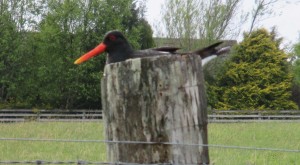 This is a critical time of the year for many of the wader family of birds that breed in the area as most of them will have chicks. Waders such as curlew, common snipe, redshank, lapwing and oystercatcher will have laid their eggs in a depression, often called a “scrape”, with very little nest lining. Their defence against would be predators, whether mammals or birds, lies in a variety of ways but camouflage is one of the key elements. This is not only the case with the adult birds, where the various barring of dark and light brown feathers hide them, but also the chicks. One problem is that the chicks will leave the nest almost straight after hatching and will be brooded by the adult when necessary. However, when left the chicks have a very intriguing pattern of feathers to enable them to be camouflaged. The dark browns of the head and body are separated by lighter feathers around the neck areas. From above this breaks the outline of the chick into two roundish shape, just like pebbles or stones, and so the chick is camouflaged.
This is a critical time of the year for many of the wader family of birds that breed in the area as most of them will have chicks. Waders such as curlew, common snipe, redshank, lapwing and oystercatcher will have laid their eggs in a depression, often called a “scrape”, with very little nest lining. Their defence against would be predators, whether mammals or birds, lies in a variety of ways but camouflage is one of the key elements. This is not only the case with the adult birds, where the various barring of dark and light brown feathers hide them, but also the chicks. One problem is that the chicks will leave the nest almost straight after hatching and will be brooded by the adult when necessary. However, when left the chicks have a very intriguing pattern of feathers to enable them to be camouflaged. The dark browns of the head and body are separated by lighter feathers around the neck areas. From above this breaks the outline of the chick into two roundish shape, just like pebbles or stones, and so the chick is camouflaged.
The adults out on a field or open moorland are, in the main, well camouflaged but there is an exception and that is the oystercatcher. The conspicuous black and white plumage, even more conspicuous when they are in flight, is offset by that enormous orange red beak and reddish pink legs. You might well overlook the large curlew or the redshank and especially the common snipe, even when they are in the open, but not so the almost flamboyant oystercatcher. Yet in the various straths around Inverness and areas adjoining the coast the oystercatchers seem to get away with a better breeding success than the other waders. This is surprising when another trait of this enigmatic bird is considered. Curlews, redshank and common snipe will nest in quite long grass that helps with their problem of concealing themselves. Not so the oystercatcher that sometimes seems to choose some rather unusual places to lay their four eggs. The tops of buildings, such as the former Academy School in Inverness, was one usual place. I have found them on roadside verges only a few inches from the tarmac but the site chosen by one pair must top all of these. The oystercatcher was photographed by a reader and it is near Gorthleck, Inverness and its nest site is in a depression in the top of a stout fence post. You can see by the photograph just how exposed and conspicuous the bird is sitting on its nest and eggs. I once knew of a similar site some years ago near Avoch on the Black Isle where the bird came back year after year so presumably was successful.
The oystercatchers that nest inland will not stay there for the rest of the year as once the young are fully fledged and flying well the whole family will move to the coast. There they will gather in quite large numbers, especially near sheltered areas with an abundance of food such as the vast mudflats. When they assemble in large numbers on saltmarsh or fields between tides they can be a spectacular sight especially from a hide, such the RSPB one at Udale Bay, west of Cromarty. However these very large winter flocks are not all they appear to be. Many of the birds will be from Scandinavia or Iceland with the “Scottish” breeding birds moving south to England, Wales or Ireland with a few travelling even to Spain.
Tags: highland wildlife
